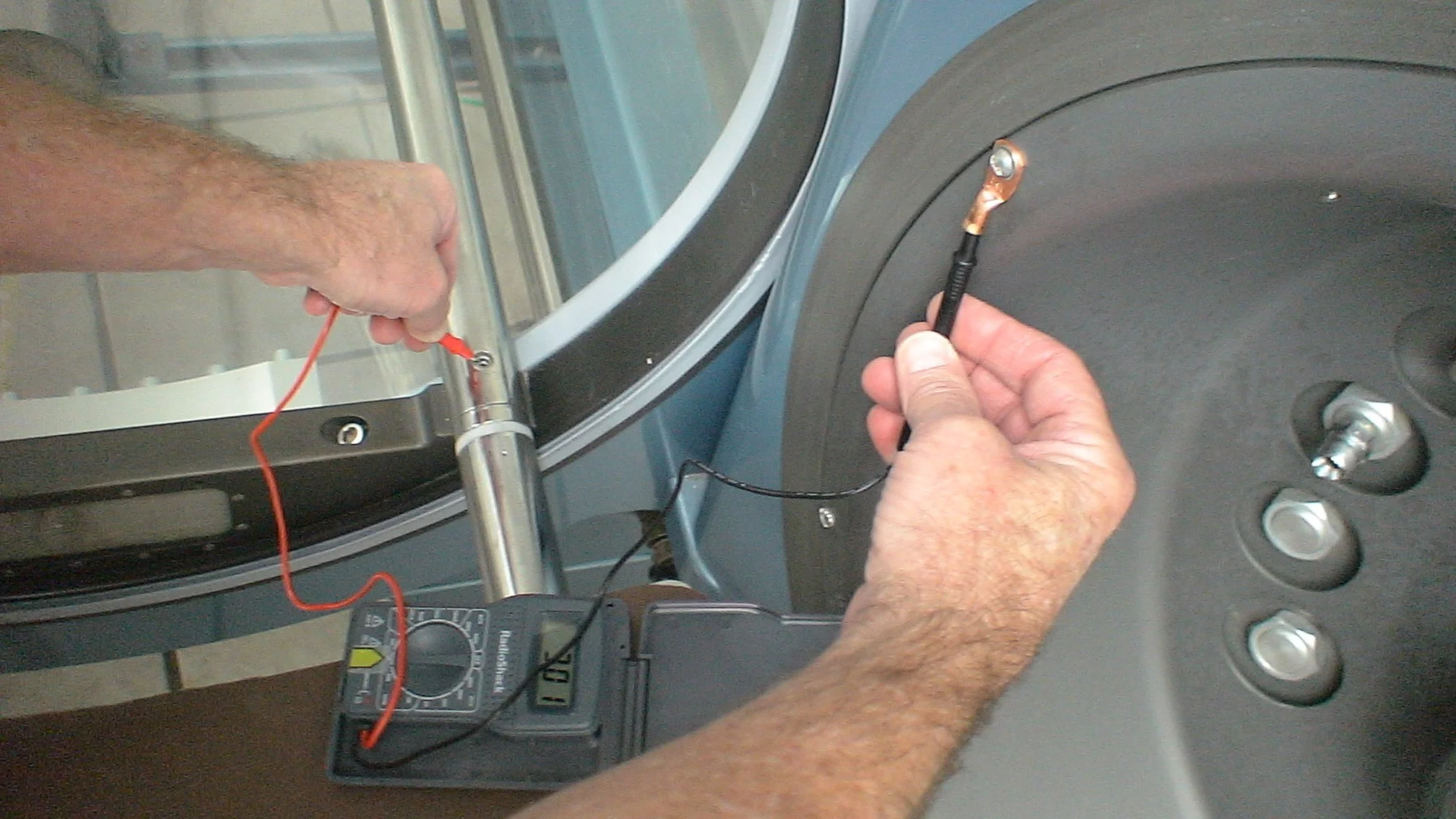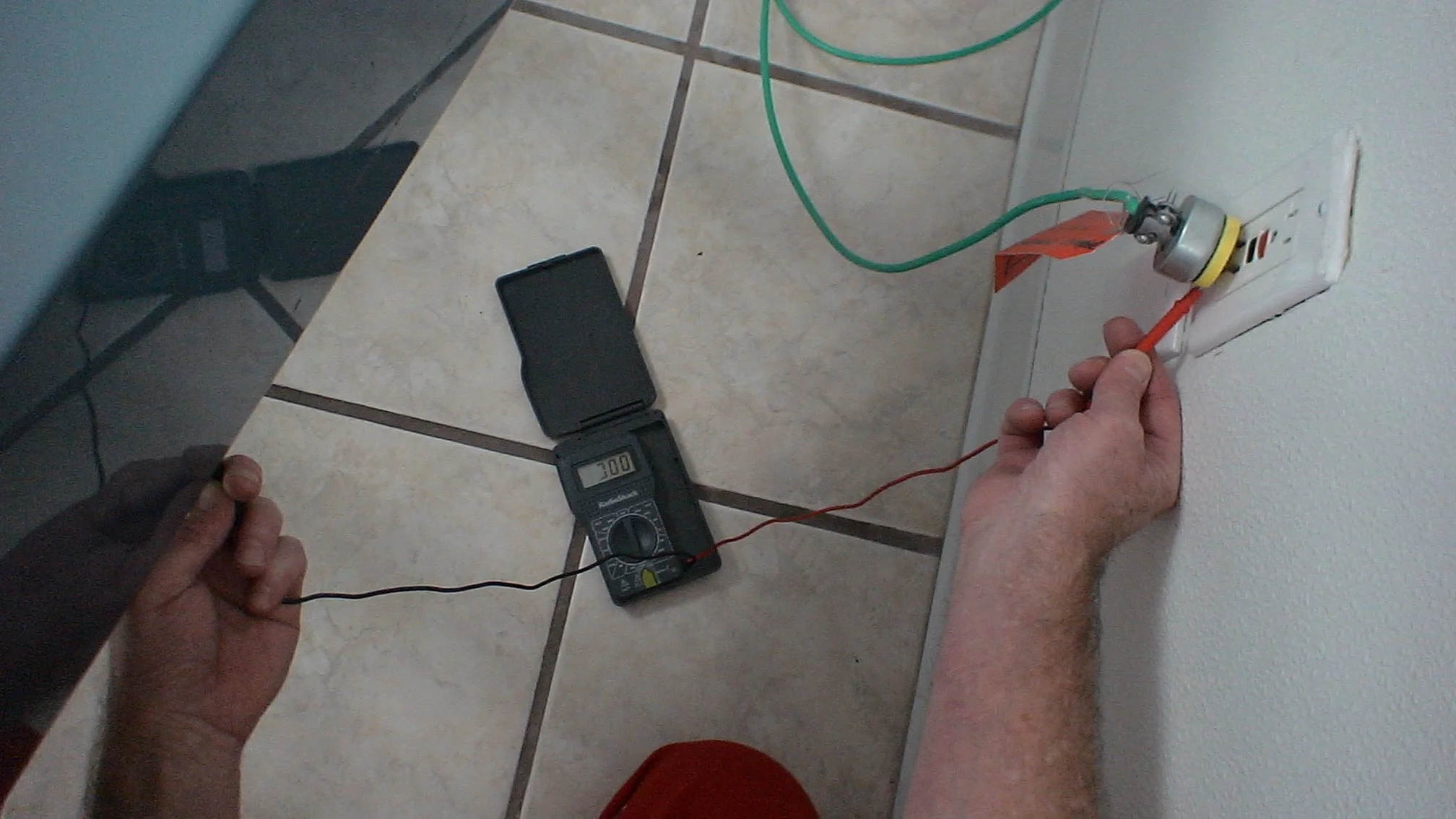HBOT Safety/Review Questions #4
Prevention of static through the use of cotton fabrics is one method of static control.
Proper grounding of the chamber is another method. Please describe the type of instrument used to check for adequate grounding of the hyperbaric chamber, and how often you should perform this procedure.
ANSWER: An Ohm meter should be used to check for proper grounding of the chamber. A multimeter may be used for this task, which should be performed daily (along with the calibration of the oxygen monitor) before treatment sessions begin. Set the meter to read ohms resistance. [Picture 1]. Test the bare metal of the chamber floor or gurney rails versus the chamber metal door [Picture 2]. Test the chamber metal wall [unpainted area or bolt] versus the ground pole of the grounding site on the wall. [Picture 3] Do NOT test versus "hot" or "electrified" poles of the plug or electrical outlets. This is dangerous to you and may damage the meter.
In this example the plug is connected to the wall ground ONLY by the ground pole. The wires on the"hot" poles are not connected inside the plug. All values should be less than 25 Ohms, and will usually read Zero or close to Zero for an acceptable ground [Picture 1].
You are employing adjuvant HBOT on a Pomeranian with a thermal burn, a cat with lumbar spinal stenosis, and a tiny puppy with head trauma secondary to a fall from an owner's arms.
They are all outpatients on the same day, and scheduling issues dictate that they be treated at the same time in your chamber. You have them placed inside three individual clear polycarbonate treatment modules so that the patients can not come into contact with each other to create static electricity discharge or traumatic injuries. Please describe a method to safely block them from viewing each other in the chamber, while still allowing an unimpeded field of vision to the observer outside the chamber.
ANSWER: "Blockers " can be deployed to cover the ends of the treatment modules so that the patients do not have to view each other while they are treated in separate modules. These "blockers" must be made of 100% cotton cloth and 100 % cotton gauze to reduce the potential for static formation . Cotton is the fabric with the least potential for the static formation, and has a relatively low potential for ignition from sparks [reference Hyperbaric Facility Safety , Workman, WT, Best Publishing, 1999, page 530]. The following pictures show examples of the use of such "blockers".
Prevention of static through the use of cotton fabrics is one method of static control. Proper grounding of the chamber is another method. Please describe the type of instrument used to check for adequate grounding of the hyperbaric chamber, and how often you should perform this procedure.
You are treating a canine with chronic diabetes mellitus for severe acute pancreatitis with adjuvant HBOT BID.
The patient is on twice daily insulin and an IV dextrose drip as well. The dog is not yet eating, and has been vomiting. Please discuss the ideal timing of the treatment sessions in relation to the medication schedule. What blood test will you check before each HBOT session (and why) in this critically ill patient? Explain exactly how you will time your blood draw and the importance of the timing relationship between the blood draw and the suspension of the IV therapy for the blood draw and subsequent HBOT session.
ANSWER: In this patient, it is important to check a blood glucose immediately before any HBOT session. The patient is not receiving oral nutrition yet, and is being administered an IV solution containing dextrose along with BID insulin injections. The blood glucose at any given time is likely to be unpredictable.
Patients should NOT be placed in the chamber if they are HYPOGLYCEMIC, as HBOT potentiates insulin and can further lower blood glucose. A series of HBOT sessions tends to lower insulin requirements in patients with diabetes mellitus (Reference, Wilkenson, DC et al, "Hyperbaric Oxygen Therapy Ameliorates Insulin Resistance in Individuals With and Without Type 2 Diabetes", UHMJ, Vol 39, No. 5, Sept/Oct 2012, page 1014).
The IV dextrose infusion should be discontinued 10 minutes prior to the blood draw so that you can determine the current blood glucose without IV supplementation, as the patient will not be on the IV during the HBOT session. Ideally, HBOT sessions may be timed so that they occur and end just prior to each dose of insulin. As a starting point, the dosage of insulin may be initially reduced approximately 25% from the dosage given to the patient before the initiation of HBOT therapy, and adjusted afterward based on follow up blood glucose determinations.
You are treating an epileptic canine with multiple shearing wounds with adjuvant HBOT.
Which of the following is NOT a potential strategy to reduce the chance of a seizure during a treatment session?
Give IV Madazolam 10 minutes prior to each HBOT session.
Vigorously exercise the patient immediately before each treatment session to raise the body temperature.
Reduce the treatment pressure from 2.0 to 1.5 ATA.
Temporarily raise oral maintenance anticonvulsant dosage.
Time the sessions to occur at the peak blood levels after oral maintenance anticonvulsant administration.
ANSWER: 2. Vigorously exercise the patient immediately before each treatment session to raise the body temperature.
Physical exercise lowers the threshold for CNS oxygen toxicity, and exercise to the point of hyperthermia increases the uptake of oxygen by body tissues. (Reference Jain, KK, Textbook of Hyperbaric Medicine, Fifth and Revised Edition, Hogrefe, pages 52-3). Thus, excessive exercise immediately prior to HBOT is not recommended. The other strategies may all reduce the potential for seizures associated with oxygen toxicity.
You have been treating a large breed, long haired canine with adjuvant outpatient HBOT for refractory osteomyelitis of a digit.
The cool weather of autumn has finally arrived. When you removed the patient from the chamber today after a session you found dozens of "seed ticks" all over its coat, which you had not noticed when you wiped him down with a damp 100% cotton cloth prior to therapy. You immediately informed your supervisor, who sprayed down the inside walls of the chamber and bedding with a flea and tick spray product. You have more treatments scheduled today. Please explain how you would proceed from here.
ANSWER: Many flea and tick control products contain some form of alcohol. This is a combustible substance. In addition, you do not want to subject your HBOT patients to a concentrated exposure to permehrins or pyrethrins, which may result in neurologic signs or seizures. You must clean the bedding in the washer. You may choose to select a "steam cycle", if available. The chamber should be thoroughly cleaned with a soapy water solution, followed by a water wipe down, and finally dried with 100% cotton towels before the next use.
Adjuvant HBOT for refractory osteomyelitis in humans is an approved therapeutic intervention in the United States, and is "third party payable" by insurance companies and government healthcare programs. (Reference, Jain, KK, Textbook of Hyperbaric Therapy, 5th Edition, 2009, Hogrefe, Page 76).
You are treating a Boxer diagnosed with fibrocartilagenous emboli (FCE) with HBOT.
You notice that as the pressure increases you hear a steadily increasing hissing sound near the chamber door which progresses to a very loud, startling "jet-like" sound of rushing gas. You notice that a small corner of the 100% cotton towel is protruding through the door seal, and the gas is rushing out of the chamber at this site. Your next action is to:
Initiate an immediate emergency. decompression by pressing the "red button"
Keep increasing pressure because the leak will eventually seal.
Continue with the treatment session because the leak is of no concern to you.
Initiate a standard, gradual decompression to end the session, inspect the door seal, move the towel from the area, and restart the session.
ANSWER: 4
Initiate a standard, gradual decompression to end the session, inspect the door seal, move the towel from the area, and restart the session
This is not an emergency, but the leak will not stop, and the door seal may be damaged if you continue the session. The patient(s) will not have to wait for 4 hours until you restart the session, as they will not have been treated for a significant length of time. Patients with FCE have an area of the spinal cord which has been deprived of blood flow and oxygen due to an occlusion of one of the small blood vessels supplying the cord. HBOT can reduce secondary spinal cord swelling, and provide oxygen to some of the hypoxic cells near the lesion site by diffusion of oxygen from the plasma of nearby collateral vessels into these tissues. This region is referred to as the ischemic penumbra, and is the area of ischemic tissue potentially destined for infarction, but not yet irreversibly injured. It is the target area for HBOT therapy in FCE, as well as in vascular ischemic disease (stroke) of the brain. (Reference Zhang, J, "Hyperbaric Oxygen For Neurologic Disorders", Best, 2008, page 15).
You are treating a canine with chronic diabetes mellitus for severe acute pancreatitis with adjuvant HBOT BID.
The patient is on twice daily insulin and an IV dextrose drip as well. The dog is not yet eating, and has been vomiting.
Please discuss the ideal timing of the treatment sessions in relation to the medication schedule.
What blood test will you check before each HBOT session (and why) in this critically ill patient?
Explain exactly how you will time your blood draw and the importance of the timing relationship between the blood draw and the suspension of the IV therapy for the blood draw and subsequent HBOT session.
ANSWER: In this patient, it is important to check a blood glucose immediately before any HBOT session. The patient is not receiving oral nutrition yet, and is being administered an IV solution containing dextrose along with BID insulin injections. The blood glucose at any given time is likely to be unpredictable.
Patients should NOT be placed in the chamber if they are HYPOGLYCEMIC, as HBOT potentiates insulin and can further lower blood glucose. A series of HBOT sessions tends to lower insulin requirements in patients with diabetes mellitus (Reference, Wilkenson, DC et al, "Hyperbaric Oxygen Therapy Ameliorates Insulin Resistance in Individuals With and Without Type 2 Diabetes", UHMJ, Vol 39, No. 5, Sept/Oct 2012, page 1014).
The IV dextrose infusion should be discontinued 10 minutes prior to the blood draw so that you can determine the current blood glucose without IV supplementation, as the patient will not be on the IV during the HBOT session. Ideally, HBOT sessions may be timed so that they occur and end just prior to each dose of insulin. As a starting point, the dosage of insulin may be initially reduced approximately 25% from the dosage given to the patient before the initiation of HBOT therapy, and adjusted afterward based on follow up blood glucose determinations.
© RKLyman, LLC. All Rights Reserved.











